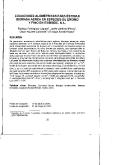| dc.contributor.author | Rodríguez Laguna, Rodrigo | |
| dc.contributor.author | Jiménez Pérez, Javier | |
| dc.contributor.author | Aguirre Calderón, Oscar | |
| dc.contributor.author | Jurado Ibarra, Enrique | |
| dc.date.accessioned | 2015-03-19T21:20:28Z | |
| dc.date.available | 2015-03-19T21:20:28Z | |
| dc.date.issued | 2007 | es_ES |
| dc.identifier | 488186 | es_ES |
| dc.identifier.issn | 2448-6671 | |
| dc.identifier.issn | 1405-3586 | |
| dc.identifier.uri | https://repositorio.catie.ac.cr/handle/11554/6093 | |
| dc.description | 18 páginas: 4 ilustraciones, 3 tablas. | |
| dc.description | Documento escrito en español con resumen en inglés. | |
| dc.description | 22 referencias bibliográficas en las páginas 55-56. | |
| dc.description.abstract | Se generaron ecuaciones alométricas para estimar biomasa aérea en cinco especies arbóreas en el bosque-escuela de la Facultad de Ciencias Forestales de la Universidad Autónoma de Nuevo León. A excepción de Quercus /aceyi, se tomaron datos dasométricos de ocho árboles por especie, que corresponden a: diámetro normal, peso fresco del fuste, las ramas y las hojas, y con muestras de cada uno de ellos, se obtuvo le relación peso seco/pes0 fresco; al multiplicar dicho valor por el peso fresco de cada uno de estos componentes, se obtuvo su biomasa y al sumar los componentes del árbol, la biomasa aérea total por árbol. La fuente de información incluyó los extremos dimensionales de diámetro normal para cada especie evaluada. Se usó el modelo de regresión potencial (/3 = a0 *D01 , donde {3 es el peso seco total de la biomasa aérea (kg), Des el diámetro normal (cm), y a0 y a1 son los parámetros a estimar); este modelo tuvo coeficientes de determinación (R2) superiores a 0.97 para cada especie. Las tendencias de as líneas de biomasa permitieron formar tres subgtupos de especies, el subgrupo 1 (Q. laceyi, Q. cambyt) resultó con R2 > 0.98, el subgrupo 2 (Q. rysophylla, P. pseudostrobus) con R2 > 0.97 y el subgrupo 3 integrado sólo por J. f/accida tuvo el R 2= 0.99. | |
| dc.description.abstract | Allometric equations were generated to estimate aerial biomass in five arboreal species in the forest-school of the Facultad de Ciencias Forestales of the Universidad Autónoma de Nuevo León. Data were taken from eight trees by species, except Quercus laceyi, The collected data are: normal diameter, fresh weight in the components of the tree (stem, branches and leaves) and with samples of each component, the relation was obtained dry weight fresh weight, this value multiplied by the fresh weight of each component of the tree obtains biomas and adding each component of the tree obtained total aerial biomass by tree. The source of information included the dimensional extreme of normal diameter for each evaluated species, The potential model of regression was used (β= a0 *Da1 where β it is the dry weight total of the aerial biomass (kg), D is the normal diameter (cm), and as and a, are the parameters to estimate); this model obtained coefficients of determination (R2) upper to 0.97 for each species, the tendencies of the biomass lines formed, three sub-groups of species, subgroup 1 (Q. laceyi, Q. camby) resulted with R2> 0.98, sub-group 2 (Q. 1ysophylla, P. pseudostrobus) with R2> 0.97 and single integrated sub-group 3 by y. flaccida with R2= 0.99. | |
| dc.language.iso | es | es_ES |
| dc.publisher | CATIE, Turrialba (Costa Rica) | es_ES |
| dc.relation.ispartof | Revista Ciencia Forestal en México Volumen 32, número 101 | |
| dc.source | Revista Ciencia Forestal en México Volumen 32, número 101 (Enero-Junio), páginas 39-56 | |
| dc.subject | QUERCUS RYSOPHYLLA | es_ES |
| dc.subject | QUERCUS CAMBYI | |
| dc.subject | QUERCUS LACEYI | |
| dc.subject | PINUS PSEUDOSTROBUS | |
| dc.subject | JUNIPERUS FLACCIDA | |
| dc.subject | BIOMASA | |
| dc.subject | ESTIMACION | |
| dc.subject | BOSQUES | |
| dc.subject | ARBOLES | |
| dc.subject | MEDICION | |
| dc.subject | DENDROMETRIA | |
| dc.subject | MODELOS | |
| dc.subject | ECUACIONES ALOMETRICAS | |
| dc.subject | BIOMASA AEREA | |
| dc.title | Ecuaciones alométricas para estimar biomasa aérea en especies de encino y pino en Iturbide, N.L. | es_ES |
| dc.type | Artículo | es_ES |


